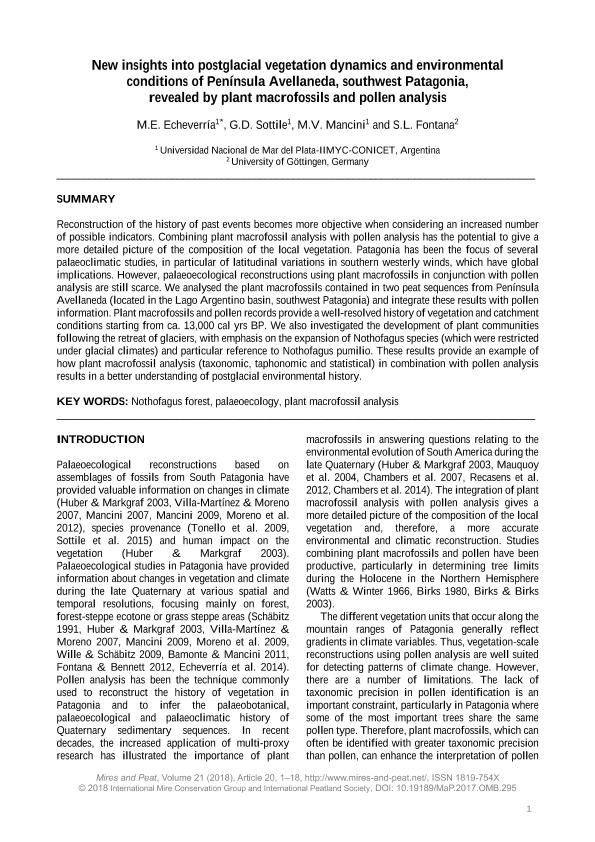Artículo
New insights into postglacial vegetation dynamics and environmental conditions of Península Avellaneda, southwest Patagonia, revealed by plant macrofossils and pollen analysis
Echeverria, Marcos Emanuel ; Sottile, Gonzalo David
; Sottile, Gonzalo David ; Mancini, Maria Virginia; Fontana, Sonia Leonor
; Mancini, Maria Virginia; Fontana, Sonia Leonor
 ; Sottile, Gonzalo David
; Sottile, Gonzalo David ; Mancini, Maria Virginia; Fontana, Sonia Leonor
; Mancini, Maria Virginia; Fontana, Sonia Leonor
Fecha de publicación:
09/2018
Editorial:
IMCG and IPS
Revista:
Mires and Peat
ISSN:
1819-754X
Idioma:
Inglés
Tipo de recurso:
Artículo publicado
Clasificación temática:
Resumen
Reconstruction of the history of past events becomes more objective when considering an increased number of possible indicators. Combining plant macrofossil analysis with pollen analysis has the potential to give a more detailed picture of the composition of the local vegetation. Patagonia has been the focus of several palaeoclimatic studies, in particular of latitudinal variations in southern westerly winds, which have global implications. However, palaeoecological reconstructions using plant macrofossils in conjunction with pollen analysis are still scarce. We analysed the plant macrofossils contained in two peat sequences from Península Avellaneda (located in the Lago Argentino basin, southwest Patagonia) and integrate these results with pollen information. Plant macrofossils and pollen records provide a well-resolved history of vegetation and catchment conditions starting from ca. 13,000 cal yrs BP. We also investigated the development of plant communities following the retreat of glaciers, with emphasis on the expansion of Nothofagus species (which were restricted under glacial climates) and particular reference to Nothofagus pumilio. These results provide an example of how plant macrofossil analysis (taxonomic, taphonomic and statistical) in combination with pollen analysis results in a better understanding of postglacial environmental history.
Palabras clave:
NOTHOFAGUS FOREST
,
PALAEOECOLOGY
,
PLANT MACROFOSSIL ANALYSIS
,
PATAGONIA
Archivos asociados
Licencia
Identificadores
Colecciones
Articulos(IIMYC)
Articulos de INSTITUTO DE INVESTIGACIONES MARINAS Y COSTERAS
Articulos de INSTITUTO DE INVESTIGACIONES MARINAS Y COSTERAS
Citación
Echeverria, Marcos Emanuel; Sottile, Gonzalo David; Mancini, Maria Virginia; Fontana, Sonia Leonor; New insights into postglacial vegetation dynamics and environmental conditions of Península Avellaneda, southwest Patagonia, revealed by plant macrofossils and pollen analysis; IMCG and IPS; Mires and Peat; 21; 9-2018; 1-18
Compartir
Altmétricas



